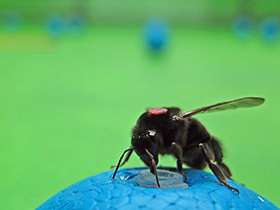Bumble bees make a beeline for larger flowers

Bumble bees create foraging routes by using their experience to select nectar-rich, high-rewarding flowers. A study by Shohei Tsujimoto and Hiroshi Ishii of the University of Toyama in Japan now suggests that bees actually forage more efficiently when flower sizes are large rather than small. This indicates that for these insect pollinators foraging quickly is more efficient than foraging accurately. The research is published in Springer's journal Behavioral Ecology and Sociobiology and uses a laboratory-based experiment to investigate how aspects of associative learning influence how bumble bees find food among different-sized flowers.
The researchers examined the trade-off between speed and accuracy that occurs when bumble bees (Bombus ignites) are presented with new foraging areas. To do so, they introduced the insects to different-sized artificial flowers that were set out in a flight cage. The flowers had styrene foam centres which were embedded with nectar providers. These allowed for a sucrose solution to be automatically replenished. When an array of flowers which was two centimetres in diameter was used, the bees could not easily detect the next nearest flower. However, when large flowers (six centimetres in diameter) were presented, the bees could easily recognize the next available artificial bloom.
Previous studies focusing on spatial-reward associative learning in foraging animals have assumed that foraging efficiency increases as the forager learns the locations of greater rewards. Tsujimoto and Ishii found that when the flowers were small, the bees created foraging routes by selectively incorporating the locations of high-rewarding flowers with their experience. But when the flowers were large and, therefore, more easily detectable, the bees no longer needed to consider the location of high rewarding flowers and simply flew between flowers more quickly.
"The bumble bees created a foraging route without accounting for the location of high-rewarding flowers when they could find flowers easily, but incorporated the locations of high-rewarding flowers when they could not easily find the next nearest flowers," explains Tsujimoto. "These results, together with those of other studies, show that learning could be a choice that foragers apply according to the cost-benefit balance of learning, and this is dependent on the circumstances."
"A forager that creates a route without accounting for the location of high-rewarding flowers will therefore not always be a short-sighted loser," adds Ishii.
More information: Shohei G. Tsujimoto et al, Effect of flower perceptibility on spatial-reward associative learning by bumble bees, Behavioral Ecology and Sociobiology (2017). DOI: 10.1007/s00265-017-2328-y
Journal information: Behavioral Ecology and Sociobiology
Provided by Springer





















